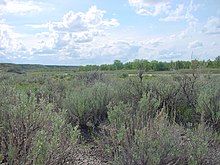|
Artemisia cana
Artemisia cana is a species of sagebrush native to western and central North America; it is a member of the sunflower family.[3][4] It is known by many common names, including silver sagebrush, sticky sagebrush, silver wormwood, hoary sagebrush, and dwarf sagebrush.[3][5][6]  Distribution and habitatArtemisia cana, Silver sagebrush, is an aromatic shrub found in grasslands, floodplains and montane forests.[7] Artemisia cana is native to the Canadian provinces of British Columbia, Alberta, Saskatchewan and Manitoba and the American states of Alaska, Oregon, California, Idaho, Nevada, Utah, Arizona, Montana, Wyoming, Colorado, New Mexico, North and South Dakota, Nebraska and Minnesota.[6][4][8] It grows in rocky, open grasslands and floodplains.[9] DescriptionThe type specimen of Artemisia cana was described informally by its collector, Meriwether Lewis (collected on October 1, 1804, in the vicinity of Centinel Creek in South Dakota, during the epic Lewis and Clark Expedition), in the following passage from Original Journals of Lewis and Clark, edited by Thwaites in 1904 :
Artemisia cana generally reaches 50–150 centimetres (20–59 in) in height, with examples west of the Continental Divide typically being shorter than those east of the divide.[3] The leaves have a narrow blade shape, are evergreen, grey-green in colour, and have a distinct aroma.[3] Subspecies
References
 External links
Wikimedia Commons has media related to Artemisia cana. |
||||||||||||||||||||||||||||||||||||||

